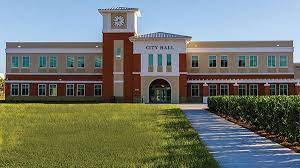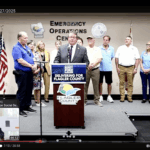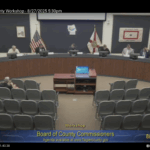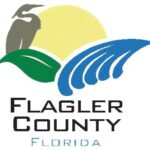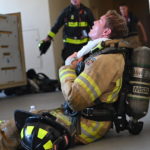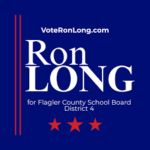On June 3, 2025, the Palm Coast City Council met at City Hall to address a variety of topics ranging from community dedications to significant ordinance considerations. The meeting began with a ceremonial dedication of the John Nets Community Wing, honoring Palm Coast’s second mayor and long-serving city council member. The plaque unveiled describes John Nets’s service, noting his over 15 years of leadership during the city’s formative years and growth phases. Speakers recalled his steadfastness and dedication, including Councilman Sullivan who shared personal memories of Nets’s community involvement. Kathy Riker Dowski, representing the Palm Coast Historical Society, highlighted Nets’s role as the society’s past president and his vision for the future of local historical preservation.
Following the dedication, the council adopted a proclamation recognizing Flagler Cares on their 10th anniversary. CEO Carrie Baird provided an overview of the organization’s expansion in behavioral health, social services, and prevention initiatives across Flagler County. She emphasized Flagler Cares’ “no wrong door” policy and shared data reflecting over 1,500 individuals served recently. Baird highlighted their coordinated opioid recovery program, showing a significant reduction in opioid overdose deaths from 42 in 2022 to 14 in 2024.
The meeting then shifted focus to community concerns voiced during public participation. Residents expressed opinions on various topics including development impact fees, short-term rentals, commercial vehicle parking, airport noise pollution from training aircraft emitting lead, and rising utility bills. Jeremy Davis addressed potential conflicts of interest with city management decisions, while other residents like Andy Dodic and Ken McDowell advocated for better fiscal policies such as upfront development impact fees and district-based budget accountability. Concerns over neighborhood disruptions from VRBO rentals and short-term rental enforcement were raised by Dennis Sakola and others.
A significant portion of the meeting centered on the first reading of amendments to transportation impact fees. Comprehensive presentations from city staff and consultants detailed proposed rate adjustments, removal of certain roadway improvements like US Highway 1 from fee calculations, and inclusion of anticipated funding from state transportation programs. The updated fee proposal introduced a tiered rate system for single-family homes, distinguishing those above and below 2,000 square feet in size, with fees ranging approximately from $4,600 to $6,000 per unit. Discussions highlighted the complexities of balancing growth funding with housing affordability while ensuring legal defensibility amid evolving state legislation. Council members debated the inflation projections and realistic state funding expectations, resulting in a decision to table the fee adoption pending further analysis and updated figures at an upcoming workshop.
Subsequent ordinances adjusted impact fees related to fire and rescue services and park systems. The fire impact fee study reflected increased equipment and facility costs due to inflation, with proposed residential fee increases nearing 114%. Staff recommended utilizing an extraordinary circumstances clause to implement these fees without phased increases, based on the city’s rapid growth and rising capital costs. Public comments acknowledged support for adequate fire services while urging caution regarding fee increases. The parks impact fee study indicated a reduction in overall capital projects due to council direction, resulting in lower proposed fees, though still on the higher end compared to similar communities. Conversations emphasized the importance of parks for community quality of life and property values, balanced against budget realities.
The council then addressed resolutions approving ground lease agreements with telecommunications companies Diamond Towers 5 LLC and Wireless Edge Towers 3 LLC for new cell towers at Fire Station 22 and the Water Treatment Plant 2 site. Presentations described lease terms, anticipated revenues, and motivations for these installations, including improved cell coverage and utility meter reading automation. Multiple residents voiced opposition, citing health concerns related to 5G technology, possible impacts on property values, and the visual of the towers in residential neighborhoods. City officials responded regarding land use restrictions and the necessity of upgraded infrastructure, noting regulatory compliance and efforts to ease the aesthetic impacts.
In the final portion of the meeting, the council considered an interlocal agreement with the Flagler County Sheriff’s Office for the temporary assignment of Chief Strobridge as an executive staff member to assist city management through a transitional period. Questions arose about potential conflicts of interest due to the sheriff’s office’s contractual relationship with the city, which is in the 9 million dollar range. The city manager clarified that Chief Strobridge’s role excludes budget oversight related to the sheriff’s contract and emphasized the need for additional experienced leadership with the vacancies in key city positions. Both council members and public commenters debated the pros and cons of this arrangement, with the resolution ultimately passing by a four-to-one vote. Resident concerns have been raised regarding the fact that Strobridge is Chief of Staff for the FCSO, and some residents shared concerns about whether Strobridge could legally work for both agencies simultaneously.
The meeting concluded with multiple council members sharing updates and gratitude for community events, and several residents reiterated concerns about transparency, public engagement, and environmental issues, most notable was the air pollution linked to local airport activity. Council members acknowledged these concerns, promising ongoing attention to these issues.


